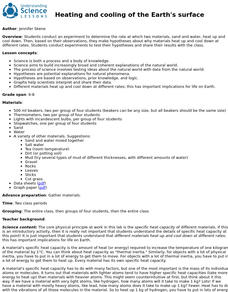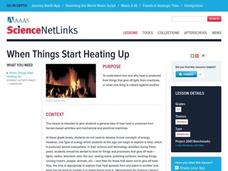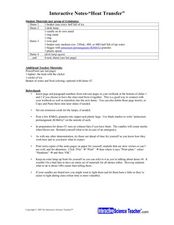NASA
Feel the Heat
Heat water up like a NASA engineer. Using the engineering design process, investigators create a system to trap and move heat through a water-filled tube. Designers participate in a post-activity discussion that highlights the role of...
Curated OER
Where's the Heat?
Review heat transfer with your seventh graders and guide them in making a practical application. Learners use a paper cutout spiral to locate convection currents in the classroom and throughout the school. They record the temperature at...
Curated OER
Heat and Conduction
This simple activity is ideal for upper elementary learners when studying physical science. Using their sense of touch to describe how hot something feels, and then comparing their observations to thermometer measurements, they discover...
Virginia Department of Education
Heat Transfer and Heat Capacity
It's time to increase the heat! Young chemists demonstrate heat transfer and heat capacity in an activity-packed lab, showing the transitions between solid, liquid, and gaseous phases of materials. Individuals plot data as the changes...
Virginia Department of Education
Molar Heat of Fusion for Water
How can you describe heat of fusion in a way the class understands and relates the importance of this concept to present day issues? In this third lesson of the series, learners conduct an experiment, demonstrating the flow of heat...
NOAA
The Climate Team: Make a Solar Heat Engine
Learners investigate how solar energy is converted into heat in part two of the 10-part Discover Your Changing World series. They build and test homemade solar cookers to boil water and cook rice. Pupils consider the impact of heat...
University of California
Heating and Cooling of the Earth's Surface
Scholars collect data from heating sand and water before forming testable hypotheses about why sand heats up faster. Afterward, they develop and run experiments to test their hypotheses.
DiscoverE
Solar-Heated Water
Heat up some interest in solar energy. Young engineers create a water heater that runs on solar power (simulated by a lamp). Using thermometers, they determine the change in temperature before and after the water goes through the heater.
Chemistry Collective
Virtual Lab: Measuring the Heat Capacity of an Engine Coolant II (Advanced Version)
Cool it! A virtual lab has users conduct an experiment to find the specific heat capacity for an unknown substance. The substance is an engine coolant, and calculating the specific heat capacity lets learners determine if it is a better...
Chemistry Collective
Virtual Lab: Determining the Heat of Reaction in Aqueous Solution
It's gettin' hot in here! An investigative activity has learners measure the heat of reaction in a virtual setting. After exploring the reaction, they attempt to create a solution at an exact temperature.
Teach Engineering
Light vs. Heat Bulbs
Careful, that light bulb is hot! Compare heat and light energy using a simple light bulb. The exercise addresses energy conservation and presents actual calculations to determine the most cost-effective light bulb.
Chemistry Collective
Virtual Lab: Measuring the Heat Capacity of an Engine Coolant
Combine automotive science with chemistry! Young scholars investigate an alternative to the traditional engine coolant. They mix the chemicals virtually and collect data to determine the specific heat capacity.
Curated OER
Energy Transfer (Heat)
The pages of this resource are in landscape view and ready-made to use as slides in a presentation on energy transfer in your high school physical science course. Begin with pertinent vocabulary and finish with an explanation of the...
Curated OER
Teaching about Heat Budgets of Lakes
Students investigate how much energy is stored in lake water as latent heat, calculate how much latent heat is exchanged with the atmosphere, and consider the effects of heat gain and heat loss on the surrounding environment.
Curated OER
Chemistry Lab-Heat of Fusion
Students determine the heat of fusion of ice. In this heat of fusion lesson plan, students use a calorimeter to measure the molar heat of fusion of ice. Students determine the heat required to melt one mole of ice using hot water and ice...
Curated OER
When Things Start Heating Up
Students explore how and why heat is produced from things that give off light, from machines, or when one thing is rubbed against another. They participate in several hands-on activities designed to help them realize that heat is related...
Curated OER
Interactive Notes-"Heat Transfer"
Students explore heat transfer. In this temperature and molecule behavior lesson, students view a PowerPoint while simultaneously performing experiments in which heat transfer is demonstrated. Students use cold beakers, ice cubes,...
Teach Engineering
Efficiency of a Water Heating System
Tired of waiting for hot water? Groups of three determine the efficiency of an electric water-heating device. They calculate the amount of energy it takes to heat the water and the theoretical amount of energy required to heat the water....
Concord Consortium
Specific Heat and Latent Heat in Condensation
There's more to melting than meets the eye! Junior physical chemists investigate the differences between specific and latent heats as a substance undergoes a phase change. Users remove heat from the system and observe changes in kinetic...
Pingry School
Determination of the Specific Heat of an Element
Many periodic tables mention specific heat, but how do scientists determine those numbers? Scholars attempt to find the specific heat of a metallic element by using a calorimeter. Three experimental trials ensure accuracy, and analysis...
NASA
The Heat is On: Urban Heat Islands, Detection Strategies, and Mitigation Solutions
It's sure getting hot out there! Scholars analyze satellite data on land use and surface temperatures, and then learn how to ground truth satellite data through an activity. They apply technology to identify urban heat islands and...
American Chemical Society
Heating Can Make a Change That Cannot Go Back Again
Heat is a gateway to change. While exploring the properties of baking powder, pupils learn that some heat-related changes are permanent. Using an animation, the lesson uses chocolate chip cookies as an example.
Curated OER
When Things Start Heating Up
Students develop a clearer understanding of how and why heat is produced from things that give off light, from machines, or when one thing is rubbed against another.
Captain Planet Foundation
Solar Cooking Race
Study heat transfer with activities that focus on how heat energy works. Using a solar cooker, ice cubes, and heat transfer bracelets, kids experiment and record what they find by keeping ice cubes cold and vegetables hot.
Other popular searches
- Heat Transfer
- Heat Energy
- Specific Heat
- Heat Capacity
- Heat and Temperature
- Color and Heat Absorption
- Heat Absorption
- Conduction Heat Transfer
- Heat Conduction
- Conducting Heat
- Heat and Evaporation
- Heating and Cooling

























